.jpg?width=740&name=shutterstock_1028392663%20(1).jpg) Are you having doubts whether budgeting for translation services is reasonable these days?
Are you having doubts whether budgeting for translation services is reasonable these days?
Or, are you responsible for your organization's international growth, and your translation budget is keeping you awake at night?
When fishermen can’t go to sea, they mend their nets. This proverb proved true after the pandemic hit, and many companies had to change their ways, directing their operations through Internet.
This indeed poses a threat to many organizations and damages businesses, but it also opens new doors.
When your online presence is now of bigger importance and doing business remotely is the new normal, consider presenting your product to markets you never dreamed of reaching in person.
Secure the budget needed to repair the nets and establish a brand new worldwide level of communication with your potential clients through localization.
ATL was there for its clients during the Great Recession 2007-2008. We understand your dilemma of balancing between what you need and what you can afford.
The good news is that you can save on buying professional translation services from a transparent translation company, and this article will show you how to do it based on a real-life example.
.png?width=600&name=how%20to%20save%20on%20professional%20translation%20services%20(1).png)
There are a couple of ways to save money when purchasing translation. This article focuses on the use of translation software, in particular, Translation Memory.
Translation software, called CAT (Computer Assisted Translation) tools, enable localization companies to lower your translation cost.
No worries, the translation is carried out by a human professional translator, but certain aspects of the process are facilitated by the CAT tools.
Translation software is a number of programs that specifically facilitate the actual localization process. In short, the majority of CAT tools have:
CAT tools import all sorts of files containing written content. It can be a document, a webpage, a list of options for your device’s UI (user interface), or captions from your video.
The content is saved into .xliff (XML Localization Interchange File Format) files and divided into the smallest, logical pieces of text, which are called segments.
The segments are presented in separate rows of text. Next to each row containing the original segment, there is an empty space waiting for its translation.

When the translation is inserted into the empty row, the original segment is saved together with its translated version.

The localization software can analyze the text in the original document and search for what is referred to as repetitions.
Repetitions are words in segments that contain exactly the same text, with identical word order and punctuation marks (coma, full stop). The number of words that are repeated in these segments is calculated and presented in the statistics.
You can see how many segments are repeated, how many words are in the repeated segments, as well as the number of characters included in the repeated segments.

Example:
The following is an example of a source content prepared for translation:
This is a sentence. This sentence is the first sentence in the document. This is a sentence. There are two identical sentences in this text. This is a sentence.
This is a sentence is the most common sentence used in this text. This is how it looks after the text is segmented by the CAT tool:

In this text, you have 42 words. Out of these 42 words, the sentence This is a sentence contains 4 words. This piece of text is repeated three times. The first occurrence needs to be translated. The second and third do not.
As a result, the statistics will show 42 words for translation, 34 of them are new, and 8 are repetitions.

Repetitions are entitled to what is referred to as a CAT discount.
It is a discount ranging from 5% to 25%, applied to your per-word translation rate. It depends on company policy, other discounts that may be applied, as well as the individual project-related factors.
Why is the discount applied, and why do translation companies charge for repeated text at all?
The discount is applied due to the fact that in most cases, the repeated text doesn’t need to be modified. However, companies charge for it because of the fact that it has to be checked. Due to the fact that languages vary, for example with regard to grammar rules, the same text can be translated differently in a different context.
Example 1: Meanings of Words
Perfect match.
This can mean, for example, a football match that you really enjoyed. But it can also mean a great relationship that resulted from watching a good match on TV.
Both sentences can be used in one text, but in a different context they mean completely different things, and need to be translated differently.
Example 2 – Grammar Rules
The suspect claims.
If the context provides the gender of the suspect, you know how to translate this sentence. If not, the first translation can refer to a male suspect, and this will be repeated throughout the text.
What if there are several suspects described in the text, and some of them are male and some are female? The translation is incorrect and needs to be fixed.
Therefore, in the majority of projects, repetitions should always be reviewed, and that is exactly the reason why you are charged for repetitions.
However, the mentioned examples are rather exceptional. Most often, the repetitions can be populated and they suit the context perfectly. Just like in the example below:

That is why you pay less for repetitions, and how you can save money when purchasing translations, thanks to the use of the translation software.
It depends on how many words are in the repeated segments.
The first important note is that you can influence the number of repetitions by using best practices in preparing content for localization. If you are preparing product descriptions, be consistent when it comes to using the description of parts that are the same for all the products.
Related content: 6 Tips on Preparing Your Content for Translation
Make sure to be consistent with the use of punctuation marks and capitalization. This may influence the calculation of repetitions.
You already know how repetitions are calculated.
Let’s check a real case study and see the actual difference between the cost of translating every word vs. the actual amount of USD paid for translation including the discount for repetitions.
Below you can see the statistics and the number of repetitions. In this case client saves 108 USD, which is near 40% of the whole project cost.
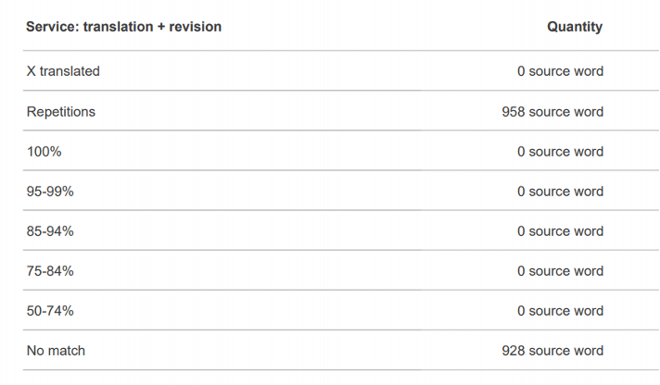
This is not a 5% or 10% discount. It is 40% saving that comes just from the proper use of translation technology.
Related content: 5 Ways That Translation Companies Cause You to Overspend
No, you don't.
Your localization company buys, manages, sets up, and uses the best features of CAT tools for your benefit.
Why is that?
Because the localization industry professionals, are there to support your localization needs, and they know that one of your concerns is a tight localization budget.
The number of repetitions is not influenced by the language you want to translate into. It depends solely on the original document.
If you want to translate a document into several languages like Italian, Chinese, Korean and Dutch, the number of repetitions will be the same. The quote will be reduced by the discount multiplied by the same number of words for each language.
In short, in the above-mentioned scenario you pay 40% less for Italian but also 40% less for Chinese as well as Korean and Dutch.
Nice? Sure, it is!
If nobody ever told you about the discount for repetitions before, I am simply thrilled to be the first to share this hint with you!
One of the reasons that you can save so much on repetitions is the Translation Memory.
The Translation Memory is a database that stores all segments together with their translations. You will have at least as many translation memories as the languages you translate into.
For example, if you translate your website into Spanish, German and Japanese, you will need three TMs; one for English-Spanish, one for English-German, and one for English-Japanese.
Depending on the number of words translated into the particular languages, the TM will contain more, or less, translated segments. This is therefore different than repetitions.
Here, you directly influence your savings by investing in more translation.
The more you translate into Spanish, the more translated segments your EN-SP TM will contain.
The degree of the source document segment that is identical to the segment saved in your translation memory is expressed as a percentage, and is called a TM match.
Related content: How Are the TM Matches Calculated [video]
When the original text and its translation, which is stored in your TM, matches the new document segment exactly, we call it a 100% match.
100% match.
• Joan went to the office. (source segment)
• Joan went to the office. (TM segment)
To qualify as a 100% match, all characters and character formatting of both the document segment and your TM segment must match exactly.
Remember, if you change the formatting or punctuation, it is no longer a 100% match. Consequently, the TM discount will be different than the one assigned to 100% TM matches.
Fuzzy match.
• Joan went to the office. (source segment)
• Joan went to the office. (TM segment)
If the text is less than 100% identical, the similarity between the content is called fuzzy match. Fuzzy matches are most often calculated as being between 50% and 99% of identical text between the analyzed document and your TM.
Example:
• Joan went to the office. (source segment)
• Joan went to the store. (TM segment)
There are usually 8-levels of match types used on word count statistics taking into consideration the TM matches.
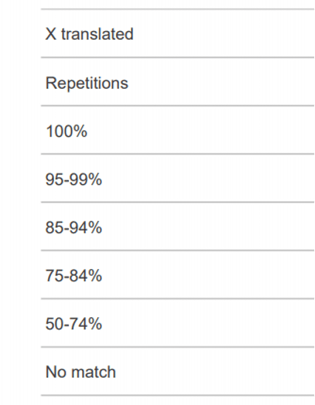
Each of the levels (except for the No match and 50%-74% match) is entitled to a discount. As you can see, there are repetitions in those categories too.
Here is an example of how it may look, when the percentage of the per-new-word rate is applied.
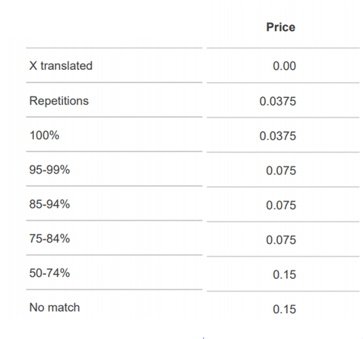
As you can see, the higher the TM match, the less you are being charged. That means that the more your TM can be reused for your new translation assignments, the more you save on the projects.
As a conclusion, the more you buy, the less you pay. But let’s look at the real money behind these calculations.
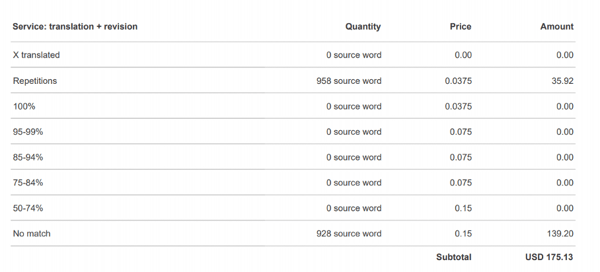
Here is the number of words that are to be translated, together with the number of repetitions that the translation software detected within the text.
When the content is analyzed against the TM, which comes from previously delivered assignments for this project, it completely changes the situation.
The translated segments stored in the TM allow us to reduce the client’s cost of translation with no damage to the translation quality (like it often happens when unfair translation agencies hire the cheapest translators, or use Google Translate).
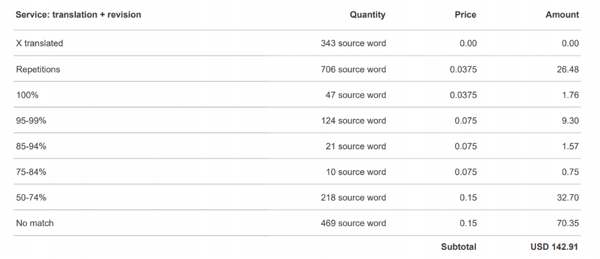
This gives us 50.8% savings compared to the cost of the same text translated without the TM, and without the use of translation software.


First of all, always insist on quotes including CAT analysis. Even if there are no TM matches, there could be repetitions. Naturally, in some cases there will be no repetitions, but insist on the localization company being clear about that.
If this is your first translation, ask to calculate repetitions, and as a result ask for discount on repetitions.
If you are assigning one project after another, make sure that the consecutive projects' cost is being calculated based on the TM built from previous translations.
With the majority of businesses operating online now, the world seems to have less distinctive borders. Invest in your online presence in order to be ready for global expansion and collect TM matches for generating savings on your translation projects.
Recommended articles:
How Much Do Translation Services Really Cost? [Rates & Factors]
+1 857 777 5741 ext. 203 (business inquiries)
+1 857 777 5741 ext. 205 (career inquiries)
Trylinskiego 16, 10-683
Olsztyn, Poland
Copyright ATL 2025. All Rights Reserved.